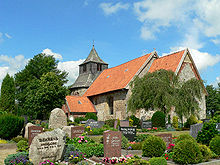St. George Church (Oeversee)
The St. George Church is a round tower church from the 12th century in Oeversee . Today she belongs to the parish Oeversee-Jarplund in the parish of Schleswig-Flensburg in the Evangelical Lutheran Church in Northern Germany .
history
The Oeverseer Church is one of the earliest church buildings in the Danish Mark , the later Duchy of Schleswig . It was consecrated to Saint George , the patron saint of travelers. Its construction was probably started under the Schleswig bishop Adelbert (1120–1135). The massive circular tower with loopholes can be described as a use fortified church close. Access to the nave through the tower was later walled up and only reopened in 1931. Until then, the men entered the church through the south portal and the women through the now half-walled north portal. In the 18th century the tower was given a baroque dome.
Similar round towers have been preserved in the Schleswig diocese in the Laurentius Church in Kosel and the Katharinenkirche in Süderstapel. All of these churches were located along the Ochsenweg , which connected Scandinavia with the rest of Europe and was also used by pilgrims on their journeys to Rome , Jerusalem and Santiago de Compostela ( Jacobsweg ).
Originally the church was a simple stone church , the choir and nave were covered with a flat ceiling. In the nave there were three small high windows on both sides, which were later walled up. One of these small windows can still be seen on the north wall. Instead, a large window was installed on the south wall. In the choir there are still the small Romanesque windows with glass paintings by the Flensburg artist Käthe Lassen .
In 1497 the choir was vaulted, the nave around 1530. The entire vault was painted. In the choir, in addition to tendrils and grotesque heads that frame the sound holes, there is a late Gothic representation of a crescent moon Madonna . The Renaissance-era paintings in the nave include a representation of the baptism of Jesus and (behind the organ and therefore not visible) an elegant couple in the costumes of the time, possibly the donors. Similar ceiling paintings have been preserved in the Flensburg Johanniskirche . The paintings were painted over in 1620. During the renovation in 1965, these original paintings were rediscovered and restored.
Furnishing
The oldest inventory items, the altar and the baptismal font, date from the time it was built. They are made of limestone and were imported from Gotland . The baptismal font was later replaced by a Rococo baptism and served as a flower box for several centuries before it came back to the church with a new base in 1965. The baroque altarpiece from 1736 has been on the north wall of the nave since the renovation in 1965.
The triumphal cross comes from the time it was painted , two wooden sculptures of Saints George and John the Baptist at the same time can be found at Gottorf Castle .
The pulpit was made in the workshop of the woodcarver Heinrich Ringerink in Flensburg at the beginning of the 17th century . On reliefs she shows scenes from the life of Jesus with Latin Bible texts, framed by virtues symbolized as female figures .
Ceiling painting in the nave. John the Baptist points to the Lamb of God .
Depiction of the resurrection of Christ on the pulpit
literature
- Hartmut Beseler: Art Topography Schleswig-Holstein. Neumünster 1974, pp. 307-308.
- Georg Dehio : Handbook of the German art monuments . Hamburg, Schleswig-Holstein. 3rd revised and updated edition, Deutscher Kunstverlag, Munich 2009, ISBN 978-3-422-03120-3 , p. 727.
Web links
- Oeversee Church at www.kirchenkreis-schleswig-flensburg.de
Coordinates: 54 ° 42 ′ 16.2 ″ N , 9 ° 26 ′ 4.6 ″ E







